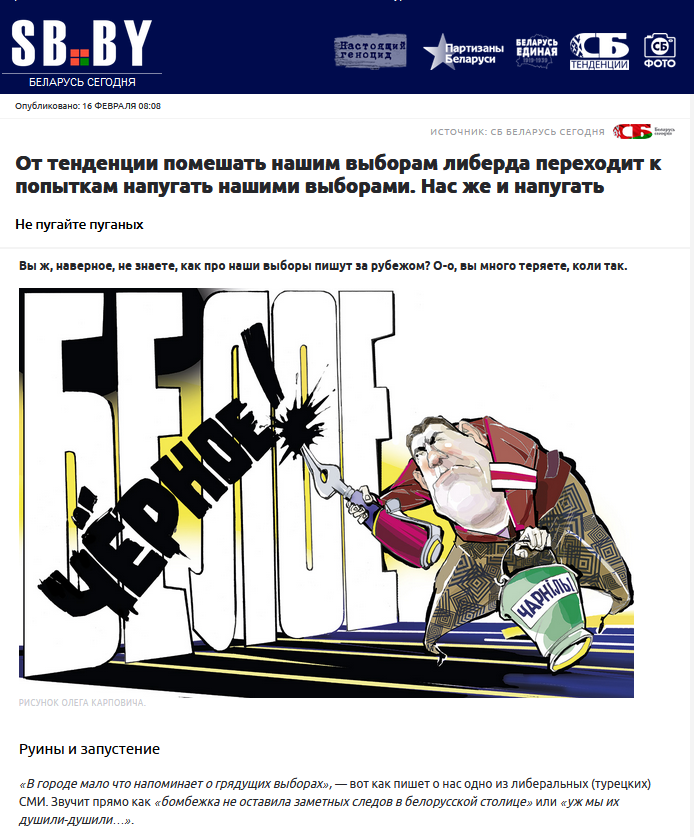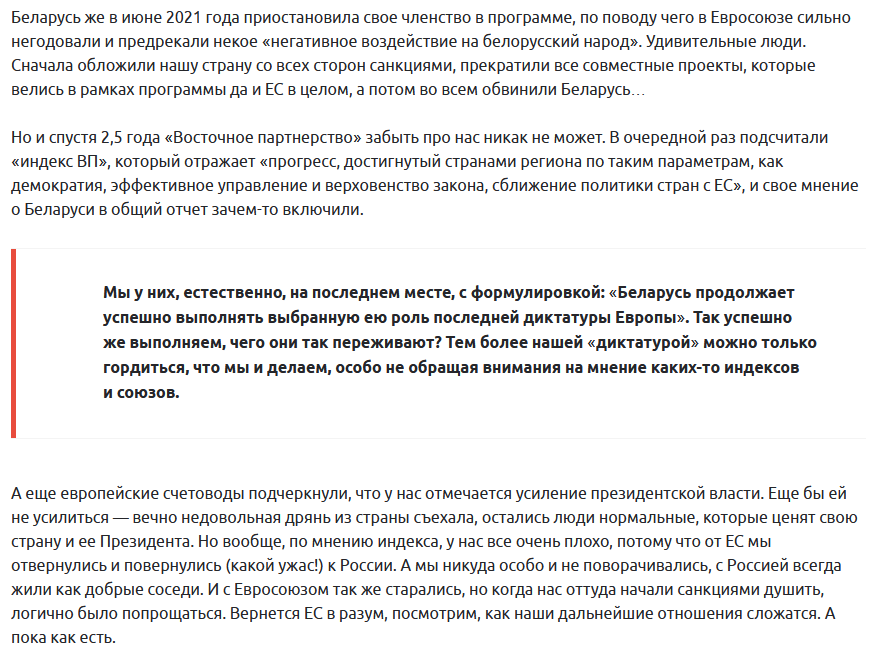We continue the monitoring that started in December 2023 – January 2024 on the topic of civil society and disinformation.
For February 2024, 1088 mentions from 83 sources of online and social media were collected. The distribution of mentions:

The peak at the end of the month is related to the beginning of preparations for the All-Belarusian People’s Assembly (VNS), in which a part of the delegates will represent what is defined by the current regime as “civil society”. Individual media began to launch narratives that this would be a certain political transition of power.
February 25, 2024, in Belarus, was the unified voting day (EDG), and state propaganda was focused on fixing the term of the correct civil society.
Nevertheless, in February 2024, there was still room for completely destructive, disinformation publications.
The most potent quote about “civil society” taken from here:

The third scenario is a long game. Its essence lies in the endeavor to subtly destabilize the country. Act covertly. Look for weak spots, try to divide society, set us against each other. In short, everything that the enemy has been doing practically throughout the entire modern history of sovereign Belarus. True, their resources are now quite limited. In the country, assemblies of sent Cossacks in the form of various NGOs, NGOs, foundations, “human rights” circles, which were carrying out destructive activities here on Western grants under various plausible signs, have been dispersed. Not a single “party” that had been feeding from the hands of foreign masters for many years dared to re-register. To the extent possible, the media field has been sanitized from parasites. We have secured ourselves in many directions. But we must not forget that hostile tactics and strategies are also evolving. Information technologies progress, and not necessarily in a constructive key. It becomes increasingly difficult to distinguish truth from lies, including in visual content. Today, we practically live in conditions where it is not so difficult to create distorted parallel realities. Such destructive tools are gaining more and more power.
Analyzing the text, we can highlight several key aspects that indicate the presence of manipulative techniques and potential disinformation:
-
Emotional coloring and language of enmity: The text contains many emotionally charged expressions and language that promotes division into “us” and “them”, enhancing the perception of a threat from external forces. Examples of such expressions include “brazen impudence”, “offspring of Western special services”, “fugitive representatives”, “strategists of chaos”. This can lead to the formation of a biased attitude towards certain groups or countries.
-
Oversimplification and generalizations: The text simplifies complex political and social processes, presenting them as black and white and ignoring nuances. For example, it is claimed that any protests or disagreements with the authorities are the result of external interference, without considering internal reasons and motivations.
-
Conspiracy theories: The text mentions “scenarios of destruction” and “fifth column”, guided by Western special services, which is a classic sign of conspiracy theories. These claims are usually generalized in nature and not supported by concrete evidence, which complicates their verification.
-
Using authority: The text refers to statements made by the President as a source of information, which can be used to lend weight to claims without providing independent sources of confirmation. This technique is aimed at strengthening trust in the text through the authority of the mentioned person.
-
Lack of evidence: Despite the seriousness of the claims, the text does not present factual data or references to sources that could confirm the information. This creates a situation in which the reader cannot independently verify the accuracy of the information.
Another example, the state-owned TV channel STV’s expert Boris Elfimov claimed “Ursula von der Leyen is to be written off, sent to scrap because of internal German squabbles”.

The text is an example of the use of disinformation and manipulative techniques aimed at discrediting certain public figures, in this case, Ursula von der Leyen, President of the European Commission, and President of Ukraine, Volodymyr Zelensky. To analyze this text for disinformation and manipulative techniques, several key aspects can be highlighted:
- Using allegory and characters from famous works: The author compares Ursula von der Leyen to the character Old Lady Shapoklyak from Soviet cartoons and literature, which is an attempt to manipulate the reader’s feelings by using cultural images with a negative context.
- Personal attacks and defamation: The text shows clear signs of personal attacks and defamation, based on subjective comparisons of political figures with negative characters, without providing facts or evidence.
- Manipulative use of facts: The claim about “fleeing from Avdiivka under the strikes of the Russian army” is presented in a context intended to discredit the actions of the Ukrainian army and its leadership, while ignoring the broad context of military actions and defensive operations.
- Lack of objectivity and one-sided presentation: The text clearly shows bias and one-sided presentation of information, aimed at creating a negative image of the mentioned persons and organizations.
- Propagandistic techniques: The use of irony and sarcasm towards political opponents, without argumentation or references to sources, serves the purpose of propaganda, not informing the reader.
Columnist Andrey Mukovozchik continued to develop “language of enmity” (hate speech). Here are some “destructive” terms he used: liberal trash (some kind of newspeak from Russia), political hacks, intellectuals, protest chicks.

Used disinformation: And what, only Poland dumped 6 billion dollars into the riot – just for leaflets, right?!
Analyzing the presented text, we can identify several characteristic signs of manipulative techniques and potential disinformation:
-
Polarization and language of enmity: The text actively uses the division into “us” versus “them”, marking opponents as “liberal trash”, “fugitives”, “foreign agents”, which contributes to the creation of an enemy image and enhances social polarization. Such language fosters distrust and aggression, reducing the chances of an objective perception of information.
-
Distortion of facts and generalizations: The text contains statements that distort real events or context, for example, regarding the financing of protests by foreign states. These statements can be intentionally exaggerated or taken out of context to reinforce a certain point of view.
-
Disputing credible sources: The text criticizes and rejects messages from foreign and independent media, accusing them of lies and manipulations. This can be a sign of an attempt to undermine trust in sources that represent an alternative point of view.
-
Conspiracy theories: Hints at conspiracies, such as “liberal trash trying to scare us with something mythical”, indicate the use of conspiracy theories as a tool to explain events without the need to provide real evidence.
-
Attacks on personality: Criticism and personalization of attacks against certain individuals, for example, mentioning “heresiarch Pavel”, are a way to discredit opponents without addressing their arguments.
-
Using authority: Repeating statements made by high-ranking individuals (for example, the President), without critical analysis or providing context, may indicate an attempt to manipulate the reader’s opinion through the authority of these persons.
Overall, the text uses a variety of manipulative techniques to influence the reader’s perception, form a certain opinion, and discredit opponents. It is important to approach such materials critically, realizing that many of the arguments presented may be intentionally distorted or presented in a way that affects emotions and public opinion.

Alena Krasovskaya of SB.BY/”Belarus Segodnya” decided to comment on the Eastern Partnership Index. She did not fail to also use the “language of enmity”. It is enough to quote such an expression: And yet, European accountants emphasized that we are witnessing a strengthening of presidential power. As if it could not strengthen — the eternally dissatisfied scum from the country fled, leaving behind normal people who value their country and its President.
The text is a commentary related to the “Eastern Partnership” program of the European Union, which discusses the interaction of the EU with countries of Eastern Europe and the South Caucasus. Analyzing the text for manipulations and disinformation, we can highlight several key aspects:
-
Subjective evaluations and emotional coloring: The text contains many emotionally charged expressions and subjective evaluations, for example, describing the UK as “deserting” from the EU, statements about the “subsidized backwaters” of the EU and characterizing Belarus as “the last dictatorship of Europe”. This can create a biased attitude towards the subject of discussion and affect the reader’s perception of information.
-
Use of irony and sarcasm: The author uses irony and sarcasm when discussing relations between countries and the EU, for example, when talking about “European happiness” or blaming Belarus for problems after sanctions were imposed by the EU. This can hinder objective perception of information and sway the reader to a certain opinion.
-
Generalizations and simplifications: The text contains generalizations and simplifications of complex political and economic processes, for example, describing complex relations between countries and the EU through the prism of one-sided interpretations. Such simplifications can mislead the reader about the real situation.
-
Lack of context: Some statements in the text may mislead due to the lack of context or additional information, for example, regarding the EU’s requirements for candidate countries for entry or the process of democratization in these countries.
-
Selective representation of facts: The text presents facts and quotes that support a certain point of view, while counterarguments or alternative opinions may be ignored. This creates an incomplete picture of the situation and can serve as a tool for manipulating the reader’s opinion.
Overall, when reading and analyzing such texts, it is important to approach the information critically, look for additional sources to fully understand the context, and avoid accepting the author’s opinions as objective facts.
Regional press invented a new type of “civil society”:
Representatives of a dead-end branch of the development of civil society looked around and suddenly realized that almost four years have passed, they are still in emigration, and new elections are taking place in Belarus. How did the electoral campaign stimulate the intra-species struggle of dependents? While the zmahar public is being tempted by the prospects of getting a refugee passport, an electoral campaign is in full swing in Belarus.











